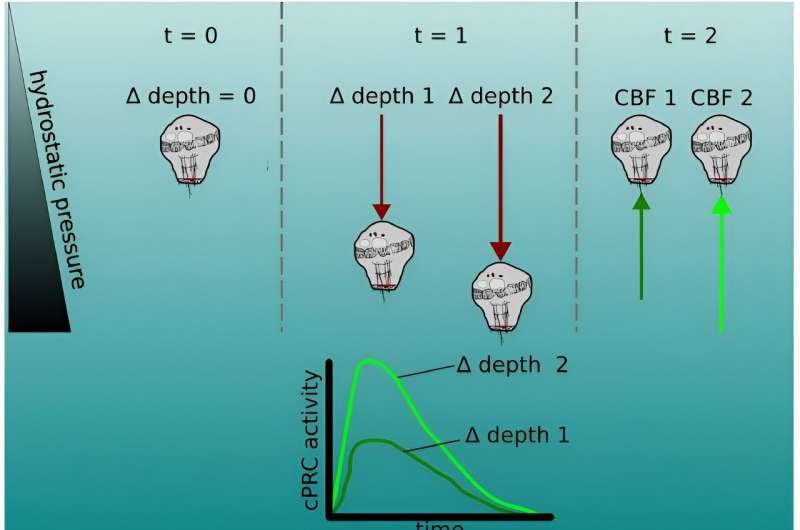
The pressure response as a depth-retention mechanism mediated by the ciliary photoreceptor-cell circuit. Credit: eLife (2024). DOI: 10.7554/eLife.94306.1
Researchers have uncovered how sea-dwelling plankton respond to pressure changes and propel themselves through the water, using tiny protrusions called cilia.
The research, presented in eLife, as a reviewed preprint, was described by the editors as a fundamental study that addresses the question of how certain zooplankton change their direction of movement in response to pressure—a phenomenon known as barotaxis.
The authors provide compelling evidence that barotaxis involves UV light sensors within cells, which interact with motor neurons in the brain to activate the rhythmical beating of cilia. The results shed light on how marine plankton sense and respond differently to opposing environmental cues, allowing them to find the optimal habitat around 0–20 m under the sea.
Hydrostatic pressure increases as water gets deeper, and this pressure can provide plankton with information about depth independently of light availability or the time of day. Many marine organisms are known to sense and respond to water pressure, but they use vastly different pressure-sensing mechanisms.
“Fish have gas-filled swim bladders that enable them to sense pressure, and some crab species have miniscule hairs thought to act as pressure detectors,” explains lead author Luis Bezares-Calderón, Postdoctoral Research Fellow at the Living Systems Institute, University of Exeter, U.K. “It is unknown which, if any, of the different pressure-sensing mechanisms seen in marine life is used by much smaller planktonic animals.”
To address this, the team used larvae of a marine worm, called Platynereis dumerilii, which are equipped with a band of tiny cilia that they use to swim. The larvae beat their cilia to swim up and down between different water depths, where they eventually settle on seagrass beds close to the coast. The mechanism by which the larvae are guided by light in their environment is well understood, making it an ideal model to learn more about sensing water pressure.
To monitor the way the plankton larvae respond to pressure, the team custom-built a water chamber where they could precisely control water pressure. They found that the larvae respond to increased pressure by swimming upward faster and in a straighter trajectory.
Higher pressure levels caused the larvae to move higher up in the chamber, and to increase the straightness of their swimming. Moreover, the increase in upward swimming was directly linked to the extent of increased pressure, suggesting that the larvae detect changes in water pressure rather than a specific pressure level.
To understand the mechanism of this change in swimming behavior, the team studied the effect of pressure on how fast the larvae beat their cilia. They found that the average beat frequency increased as soon as more pressure was applied—suggesting that the larvae respond to higher pressure by using their cilia to propel them upward.
So how do they sense this pressure change? To identify cells that are sensitive to pressure, the team used imaging and a fluorescent marker to look at nerve activity under a microscope. This identified a group of four cells in the middle of the brain that had enhanced nerve activity when pressure increased. These cells looked similar in shape, number, size and position to “photoreceptor” cells previously identified that help the plankton respond to light.
“This led us to the unexpected discovery that light receptors in the cilia, previously shown to be sensitive to both UV and green light, are also activated by pressure,” says Bezares-Calderón. “This suggests that a single cell type might integrate cues from light and pressure, where UV light triggers the plankton to swim downward away from light, and increased pressure triggers them to swim upward.”
The team sought to confirm this by removing an essential gene within the photoreceptor cells called opsin. As expected, larvae without opsin responded much less to the pressure cues and had defects in sensory cilia.
The remaining question was how the photoreceptor cells convert pressure signals into the physical movement of the cilia. Thanks to an existing brain wiring map for the plankton larvae, they found a possible connection with the brain’s serotonin signaling system. When they blocked this signaling, it dampened the pressure response, revealing that the serotonin signaling network links the plankton’s pressure sensors with its resulting physical swimming response.
“Our work provides insights into the mechanisms of pressure sensation and response in a marine plankton larva,” concludes senior author Gáspár Jékely, Professor for Molecular Organismal Biology at the Center for Organismal Studies, Heidelberg University.
“It suggests that increases in pressure—either due to the larva’s own actions of sinking or diving, or because of downwelling currents—activates sensory photoreceptor cells, which causes cilia to beat faster in a manner that is proportional to the magnitude of pressure.
“Our results show that plankton receive external light and pressure cues through a single sensory cell, and these cues then diverge in the brain to trigger different swimming behaviors that guide the plankton back into an optimal position in the water.”
More information:
Luis Alberto Bezares Calderón et al, Mechanism of barotaxis in marine zooplankton, eLife (2024). DOI: 10.7554/eLife.94306.1
Journal information:
eLife
Citation:
Study finds plankton use UV light sensors to detect pressure change and avoid getting swept away (2024, February 7)
retrieved 7 February 2024
from https://phys.org/news/2024-02-plankton-uv-sensors-pressure-swept.html
This document is subject to copyright. Apart from any fair dealing for the purpose of private study or research, no
part may be reproduced without the written permission. The content is provided for information purposes only.
>>> Read full article>>>
Copyright for syndicated content belongs to the linked Source : Phys.org – https://phys.org/news/2024-02-plankton-uv-sensors-pressure-swept.html










